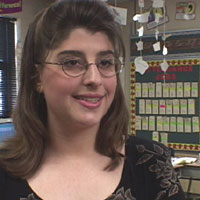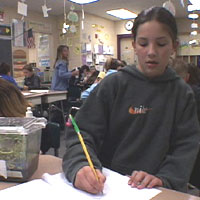Join us for conversations that inspire, recognize, and encourage innovation and best practices in the education profession.
Available on Apple Podcasts, Spotify, Google Podcasts, and more.
 “I think that when we teach life science with a hands-on constructivist method, we will bring these children’s world to them. Then they start to make the connections that we want them to make. Then they start to do that investigative thinking and that scientific thinking, and make the connections from what they see in their world to what they’re doing in the classroom, and realize that science is all around them.”
“I think that when we teach life science with a hands-on constructivist method, we will bring these children’s world to them. Then they start to make the connections that we want them to make. Then they start to do that investigative thinking and that scientific thinking, and make the connections from what they see in their world to what they’re doing in the classroom, and realize that science is all around them.”
Melissa Minnick teaches fifth grade at Glade Elementary School in Walkersville, Maryland. Located 50 miles west of Baltimore, Walkersville is a small, middle-class community. The students at Glade Elementary regularly exceed the state average on state tests.
Melissa remembers how influenced she was by an early teaching experience: “When I was seven years old, I was at a babysitter’s, and I helped a child understand subtraction as backwards addition, and when the younger child understood it, I realized that that’s what I wanted to do with the rest of my life. So, all through high school, all through college, that’s what I worked on, becoming a teacher.” It’s not surprising then, that Melissa finds the moments when she gets to watch students “grasp a concept” the most rewarding.
 Lesson at a Glance:
Lesson at a Glance:
Curriculum: SCIS 3+, Lawrence Hall of Science, Delta Education
Grade: Fifth
Topic: Communities
In the weeks before the activity in Session 7, Melissa introduced her class to the idea of the interdependence of species. They looked first at food chains, then moved onto a more accurate model, the food web.
As an introduction to the unit, Melissa’s students posted the name of an organism on their shirt and, using yarn, connected themselves to organisms that either ate them or that they would eat. The class role-played hypothetical scenarios: if the student playing “X” organism sat down—“died”—what other species would be affected? Whoever else was connected to them also had to sit down. By running more scenarios, the class started to understand the idea of interdependence. For example, what if all plants died? The whole class sat down.
Melissa’s students also built a terrarium with each student maintaining a Communities Chart to track the feeding relationships inside. Early on, the terrarium contained only a few organisms and amounted to a straightforward food chain, as did their charts. As they continued to add things to their terrariums, their charts become more complicated. For example, when crickets were first added to the terrarium, their only food source was mustard seeds; when the class added bran, however, the crickets had a choice.
Each time something was added, the students watched for its impact and recorded it on their chart. Likewise, when Melissa introduced the idea of decomposition to the class, they added molds and bacteria to their charts. At the time of the taping, the terrariums were fairly complex with Communities Charts to match.
The featured activity involved the students in identifying the creatures in their terrariums as “producers,” “consumers,” or “decomposers.” They began by observing their terrariums and discussing in groups what they were seeing. Then, the students recorded their observations, questions, and predictions in their science journals, which they maintained on a daily basis.
A class discussion followed about what they were observing, and Melissa reminded them of the terms. Using labels with the words “consumers,” “producers,” and “decomposers,” the students attached the terms to the appropriate groups on the charts. They repeated the activity as a class, keeping their own completed charts.
The goal of the unit was for her students to build their understandings of the key properties of communities – that energy flow is the connecting piece that ties a community together and that organisms depend on each other for survival.
 Lesson Goals:
Lesson Goals:
Students build and maintain a terrarium.
Students observe and describe feeding relationships among organisms in a terrarium.
Students construct food chains and webs based on observations.
Students apply the terms “producer,” “consumer,” and “decomposer” to organisms in a community.
Students describe energy flow through communities.
Consider the goals for this lesson as listed above. How can you create a lesson appropriate for your classroom that will fulfill similar goals?